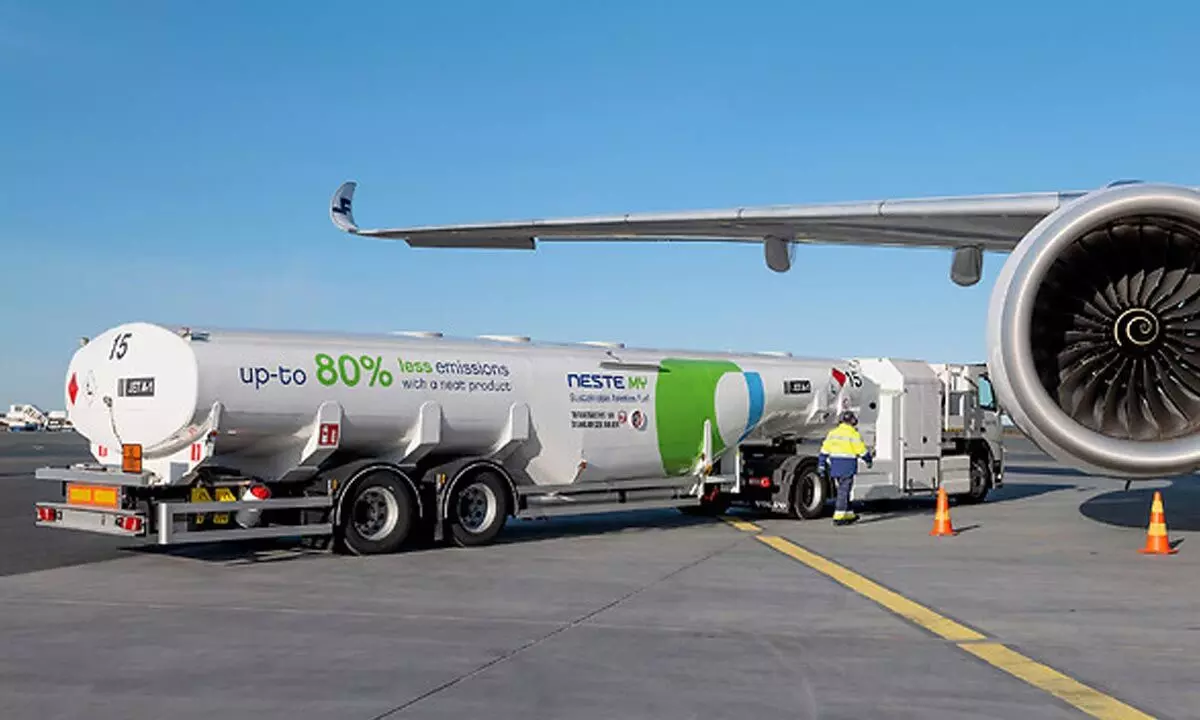Incentivising SAF production can go a long way in decarbonising aviation
Airlines are committed to achieve net zero CO2 emissions by 2050 and see SAF as a key contributor
image for illustrative purpose

The International Air Transport Association (IATA) estimates that Sustainable Aviation Fuel (SAF) production will reach at least 300 million liters in 2022 - a 200 per cent increase on 2021 production of 100 million liters. More optimistic calculations estimate total production in 2022 could reach 450 million liters. Both scenarios position the SAF industry on the verge of an exponential capacity and production ramp-up toward an identified tipping point of 30 billion liters by 2030, with the right supporting policies. Airlines are committed to achieve net zero CO2 emissions by 2050 and see SAF as a key contributor. Current estimates expect SAF to account for 65 per cent of the mitigation needed for this, requiring a production capacity of 450 billion liters annually in 2050.
Having agreed to a Long Term Aspirational Goal (LTAG) on climate at the 41st Assembly of the International Civil Aviation Organization (ICAO) in October 2022, governments now share the same target for aviation's decarbonisation and interest in the success of SAF.
"There was at least triple the amount of SAF in the market in 2022 than in 2021. And airlines used every drop, even at very high prices! If more was available, it would have been purchased. That makes it clear that it is a supply issue and that market forces alone are insufficient to solve it. Governments, who now share the same 2050 net zero goal, need to put in place comprehensive production incentives for SAF. It is what they did to successfully transition economies to renewable sources of electricity. And it is what aviation needs to decarbonise," said Willie Walsh, IATA's Director General. On the cost side, jet kerosene prices are expected to average $138.8/barrel for the year, considerably higher than the $125.5/barrel expected in June. That reflects higher oil prices exaggerated by a jet crack spread that is well-above historic averages. Even with lower demand leading to reduced consumption, this raised the industry's fuel bill to $222 billion (well above the $192 billion anticipated in June).
The total fuel spend for 2023 is expected to be $229 billion - consistent at 30 per cent of expenses. IATA's forecast is based on Brent crude at $92.3/barrel (down from an average of $103.2/barrel in 2022). Jet kerosene is expected to average $111.9/barrel (down from $138.8/barrel). This decrease reflects a relative stabilization of fuel supply after the initial disruptions from the war in Ukraine. The premium charged for jet fuel (crack spread) remains near historical highs.
To date, over 450,000 commercial flights have been operated using SAF, and the growing number of airlines signing offtake agreements with producers sends a clear signal to the markets that SAF is needed in larger quantities, and so far in 2022, around 40 offtake agreements have been announced.
Incentive-based policies
Until we have commercialized options for alternative power sources such as hydrogen, all of aviation's SAF supply will be derived from biofuel refineries. These refineries produce renewable biodiesel, biogas, as well as SAF and their refining capacity is set to grow by over 400 per cent by 2025 compared to 2022. The challenge for aviation is to secure its supply of SAF from this capacity. And to do that successfully governments need to put in place SAF production incentives similar to what is already in place for biogas and biodiesel.
The total fuel spend for 2023 is expected to be $229 billion - consistent at 30 per cent of expenses. IATA's forecast is based on Brent crude at $92.3/barrel (down from an average of $103.2/barrel in 2022). Jet kerosene is expected to average $111.9/barrel (down from $138.8/barrel). This decrease reflects a relative stabilization of fuel supply after the initial disruptions from the war in Ukraine. The premium charged for jet fuel (crack spread) remains near historical highs.
SAF is currently expected to account for 65 per cent of carbon mitigation in 2050. It will be the largest contributor to the industry's sustainability. Airlines bought every drop of SAF available in 2021 and have committed to over $17 billion of forward purchasing agreements.
Government incentives for SAF could see 30 billion liters of production capacity globally by 2030. Japan and Singapore have demonstrated an exemplary approach to SAF, actively involving the industry in the consultation process, and in promoting domestic production of SAF.

